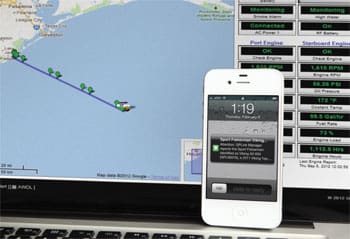Imagine yourself at work when your cell phone rings. It’s your boat calling to tell you the high water alarm has just gone off. A quick call to your dock master and a loose air conditioner hose is soon fixed. Or perhaps it is 0200 and your boat calls to tell you the aft deck laser beam has just been breached and the side deck door has been opened. You quickly key in a code that will disable the engine and all electronics. Another code and you set off an acoustic barrier effectively stopping intruders in their tracks by generating an unbearable high intensity noise. Seconds later an impenetrable cloud of smoke fills the saloon blinding the intruders. Sound a bit like James Bond or something from the future? Perhaps, but this is no James Bond movie, this type of monitoring and protection is now available to any boat owner.
Remote vessel monitoring systems that used to be reserved for large commercial vessels and megayachts are now being offered to the average boat owner, often for a surprisingly low cost. From simple systems that will monitor high water and fire alarms to high-end systems that will monitor not only the basics, but things like temperatures, tank levels and system voltages. All this can be done no matter where you or your boat are, virtually anywhere in the world. You can even remotely defend your vessel from intruders with active defense devices. Vessel monitoring has truly come of age and is now available for almost any boat or budget.
How does it work?
Remote vessel monitoring involves sensors, controls, and other equipment that are attached to a central control unit. This central control unit will then relay information about your boat to you through your cell phone or computer. It does this with a transmitter on your boat that can connect through a cell phone or satellite network. Alert messages are sent as a text or voice message to one or more cell phones. Most systems support e-mail messages as well. This allows you to not only receive a message but your captain or other representative can receive the message simultaneously. This can save critical time if you are far away from your boat. Monitoring systems can range from very simple, with just three to four sensors on board, to high-end systems that will measure everything from the height of the bilge water to the temperature in the master stateroom. Some systems have two-way communications allowing the owner or captain to set off alarms, shut down an engine or turn on the air conditioning prior to their arrival. Cameras can be used as well so that the actual condition of the vessel can be checked inside and out. The only limits to these systems are the owner’s imagination and budget.
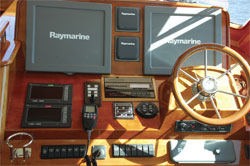 |
|
Courtesy GOST The GOST Phantom unit in the center of this Hinckley, can gather data from onboard sensors and then provide it to a remote owner. |
Remote vessel monitoring has been around for some time within the shipping industry. At first systems were developed to track vessel locations and speed for port operations. Vessel tracking systems were also developed to track fishing vessels to make sure they do not stray from approved fishing grounds and to monitor catch quotas.
Two-way communication added
This basic tracking was then combined with onboard active security systems to prevent theft. As this technology has developed and two-way communications added, its usefulness has increased. Combine this with reduced costs and it becomes more attractive to the average boater. First generation remote vessel monitoring systems were used primarily for vessel location and security. These early systems were designed to help track a vessel if stolen. This basic system has evolved to one that can monitor the location of your boat at all times as well as report on her condition. The term “geo fence” is now common within the industry. A geo fence is a geographical area where your boat is allowed to be, sort of an invisible electronic fence. This area can be as small as a few hundred feet to several miles. Should the boat go outside this area, an alarm message is sent to notify the owner or captain that the boat is on the move. If this movement is not authorized, the owner can then contact the authorities while continuing to track the boat. With newer systems, not only can the owner track the boat’s location, but they can also set off counter measures. The boat can be disabled by shutting down the engines and other systems.
Of course, the best approach is to stop the would-be thieves before they can leave the dock. Traditional security systems utilizing motion sensors, pressure switches and even canvas snap sensors can be coupled to the monitoring system to notify you as soon as an intruder boards the boat. Onboard cameras can also be used so you can see what is going on before calling the police. Some systems will require the operator to enter a code prior to being able to start the engine. Any time the engine is started a message is sent notifying the owner. You can even get active counter measures to stop a would-be thief dead in their tracks. Another great feature of the geo fence is that it can also be used as an anchor alarm. Should your vessel start to drag anchor, you will be notified immediately whether you are aboard or not.
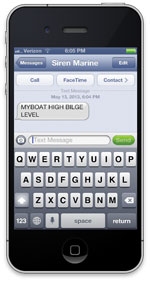 |
|
Courtesy Siren Marine Siren Marine has a monitoring setup that can push text alerts to users like this high bilge water alarm. |
Security and tracking are just the beginning with these systems. As the core unit allows two-way communications it becomes a simple matter to add conditional monitoring. Conditional monitoring is, as the name implies, the monitoring of the vessel conditions. These can be simple things such as high bilge water, AC and DC voltages and onboard environmental conditions. It can also involve more complex monitoring allowing the owner to check all tank levels, keep reports on bilge pump cycles, and view onboard cameras. Several systems allow the use of NMEA 2000 sensors and devices opening many new possibilities for what an owner can track. The use of NMEA 2000 allows the owner to take advantage of existing equipment aboard and integrate with other onboard systems. Almost any parameter that can be measured can be monitored. With this flexibility owners can always add new sensors as the need arises.
Engine monitoring
The next logical step was to add engine monitoring and some companies have begun to move in this direction. At the forefront of this is Caterpillar with their GPLink product. This system allows complete real-time engine monitoring by integrating the Caterpillar engine computers. If trouble should arise while underway, the owner or captain can contact Caterpillar who in turn can remotely read any error codes for real-time problem solving. This system can work with both main engines and generators. If your vessel is not equipped with Caterpillar engines, you can still take advantage of engine monitoring. Some companies such as Maretron can provide modules that will convert analog or J1939 engine data into NMEA 2000 data so that the remote vessel monitoring system can then transmit the data as needed. It is only a matter of time before other engine manufactures jump on the band wagon and begin producing their own versions of GPLink to assist their customers with engine related problems.
With the ability of two-way communications the owner can do more than just monitor systems, they can control them as well. Almost any piece of equipment you can control on board can be controlled remotely as well. The most obvious use for this would be to shut down engines and systems should the vessel be stolen, but this is just part of what can be done. Most systems will allow the use of electronic switches that will allow the operator to turn on and off equipment as needed. Air conditioning temperatures can be adjusted and lights turned on prior to the owner’s arrival. You can start a generator in the event of a shore power failure to protect valuable frozen foods and bait. Many owners have reported that the ability to turn on spreader or deck lights has aided in locating their boat in a crowed anchorage after a night in town.
By now many of the benefits of remote vessel monitoring can easily be seen, but there are some not-so-obvious benefits as well. The first of these is reduced insurance costs. Many insurance companies are now offering discounts for vessels equipped with remote monitoring. With some types of boats, such as center consoles, in high-theft areas the insurance companies are requiring the vessel to be equipped with at least a tracking system. Most companies will offer discounts for high water and fire alarms as well. The ability to set an anchor alarm that can be received on a cell phone is of particular benefit for anyone who anchors their boat and heads to town. Being able to explore new areas without having to worry about your boat is worth the cost alone. Some owners have even received alarm messages while aboard telling them they had high water. Upon further investigation, leaks were found and repaired before they could cause real problems.
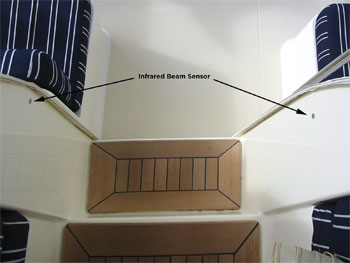 |
|
Courtesy GOST |
|
Infrared sensors can detect intruders boarding an empty boat. |
Cost and complexity
The system costs and installation depend largely on the complexity of the system. Basic units with just a few sensors start at less than $500 and are not beyond the skill level of the average boater to install. High-end systems on the other hand can cost tens of thousands and will likely require professional installation. Most simple low cost units use wired sensors although the use of wireless sensors is becoming more common and will make the installation easier. The method of data transmission can have an effect on price and installation as well. Most systems transmit data through a GSM or CDMA cell phone data network. Some systems use a satellite network exclusively or in conjunction with a cell network when in range of a cell tower. All systems require a monthly data plan as well. Costs for these data plans can vary, with simple cell connections for less than $20 per month, to more then $100 per month for satellite service.
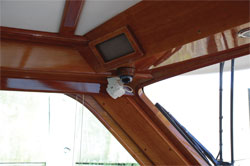 |
|
Courtesy GOST |
|
A video installation like this dome camera can allow owners to see what is taking place on their boats. |
Owners should not shop price alone, but rather look at their exact needs and consider the regions in which they plan to operate their boats. If the bulk of your boating is coastal cruising a system utilizing a cell service will likely work best, as well as being the most economical to operate. For those doing long distance offshore passages satellite service may be required. For vessels planning to visit the Caribbean, Mexico or other foreign countries, make sure the cell system is GSM compatible, is open and allows the use of SIM cards. Vessels operating in high crime areas will want to pick a system that focuses on theft prevention and tracking, while boats kept in more remote areas or on a mooring will want a system that focuses on things such as high water and low voltage alarms. Most systems can be tailored to suit the needs of the owner and new sensors can be added as needed. Pick a system that will allow expansion and future modification. As this is a relatively new industry, buyers should check the company background as well.
Although some systems may bring up images of James Bond, remote vessel monitoring has come of age for the average boater. As prices fall and features increase, these systems will soon be a standard accessory on most boats. Remote vessel monitoring can provide security and peace of mind for the owner no matter where the boat is. Ease of installation and operation make them an attractive add-on for new or old vessels.
———–
Capt. Wayne Canning lives on his Irwin 40 Vayu, in Wilmington N.C. A marine professional for more than 35 years he is now a full-time marine surveyor, freelance writer, and consultant/project manager on major repairs. Canning also runs websites for other marine professionals, and those restoring project boats. Visit www.4ABetterBoat.com and www.projectboat.info for more information.

